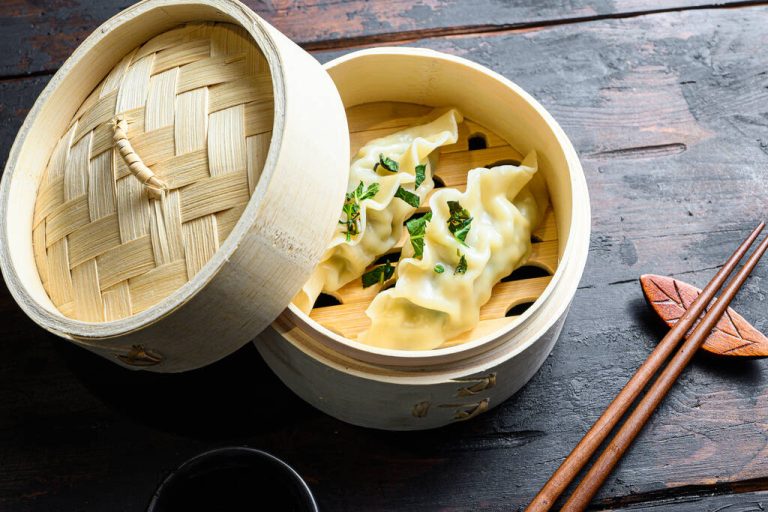Steam cooking is a centuries-old cooking method in which food is prepared in a way that is particularly gentle on nutrients and flavors. Here you can find out how steaming works, which methods are available and which ingredients are particularly suitable.
Steam cooking refers to cooking methods in which the food is not cooked directly in water but in steam. Steam cooking has a long tradition, especially in Asia, but here in Europe it only became popular in the last century.

This makes steam cooking particularly healthy
When you cook your food in water, many nutrients dissolve and are lost in the water, such as vitamin C and the B vitamins. In addition, the food loses its taste because it also releases flavorings into the cooking water. This means that steamed dishes are not only particularly healthy, they also taste more intense and you don’t have to season them as much.
Steam cooking: one word, many methods
Basically, you can distinguish between two steam cooking methods:
Steam cooking at normal pressure, i.e. at normal atmospheric pressure.
Steam cooking at increased pressure in a pressure cooker. This has the advantage that the water does not boil at 100 degrees under increased pressure, but only at 120 degrees, which means that the cooking time for the food is shorter.
There are several ways you can steam your food at atmospheric pressure. Steaming inserts for pots or woks are particularly simple and inexpensive. These can be made of metal or, as is common in Asia, of bamboo. Multiple inserts can often be stacked on top of each other so that you can prepare different dishes at the same time.
Pressure cookers are also very common. There are now even oven-sized steamers that can be permanently installed in new fitted kitchens. These are the most suitable for you if you want to steam particularly large quantities.
Another old method is steam cooking in the so-called Roman pot. This is a clay pot that is soaked in water before use, then filled with the food to be cooked and placed in the oven. Soaking the clay prevents moisture from escaping the pot. Thus, the food cooks in its own juice.
This is how steam cooking works
If you use a pot as a steamer, you need to fill it with a large enough amount of water. How much that is is often stated in the recipe. For pressure cookers, it should be in the instruction manual. It is also important that the lid of the pot closes well, otherwise the steam can escape.
So that your ingredients are cooked at the same time, you should cut them according to their cooking time. This means that foods that take longer to cook should be cut smaller than those that cook faster.
Once everything is in the pot, unless the recipe says otherwise, boil the water once and then let it simmer over medium-high heat. Steaming works best if you don’t lift the lid of the pot during the cooking process. Then no steam can escape. Instead, it condenses on the pot lid and drips onto your food – so it stays particularly juicy. Only towards the end of the cooking time should you check whether the food is done. Caution: The steam that escapes when you open the pot lid is very hot. The best way to protect your hands is with glove-shaped pot holders.
If, on the other hand, you want to try steaming in a Roman pot, it is important that you water the pot really well. He should stand in the water for 10 to 15 minutes. Then put the pot in the cold oven and only now heat it up. This is important as the clay may crack when placed in the preheated oven.
All steaming methods do not require the addition of fat. For even more flavor, you can briefly roast or caramelize ingredients such as meat or vegetables before steaming. You can then add the resulting brew to the water in the pot. Your dishes will also be particularly tasty if you enrich the water with a little vegetable broth or wine.
Which ingredients are suitable for the steam cooker?
In principle, you can steam almost anything. Steam cooking is particularly advantageous for delicate foods such as young vegetables or fish. With other cooking methods, these quickly lose their fine taste. Potatoes, yeast dumplings, rice or smaller pieces of meat are also well suited for steaming. Only foods with very long cooking times are not particularly suitable, since steam cooking takes a little longer than other cooking methods anyway.
You can best benefit from the gentle preparation in the steamer if your ingredients are really fresh and have not already lost most of their nutrients through storage. It is particularly important here that you should buy seasonal and regional products, preferably at the weekly market.

Our conclusion on steam cooking
All in all, we can recommend steam cooking as a particularly healthy, tasty and gentle cooking method. You can compensate for the slightly longer cooking times either by using a pressure cooker or by chopping your ingredients sufficiently small. Then you even save energy when steaming, because you only have to boil the water once and then set the stove to a medium temperature.
You can also cook different ingredients at the same time without their flavors mixing.

